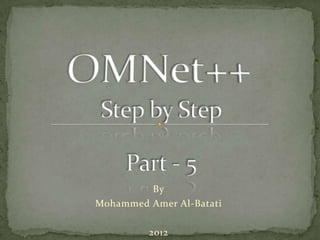Tutorial 5 adding more nodes
•Download as PPTX, PDF•
6 likes•9,184 views
Visit the source: https://omnetgroup.wordpress.com/
Report
Share
Report
Share

Recommended
Recommended
UNIT 1 CLOUD COMPUTINGUnderlying principles of parallel and distributed computing

Underlying principles of parallel and distributed computingGOVERNMENT COLLEGE OF ENGINEERING,TIRUNELVELI
Systèmes Multi agents : Concepts et Mise en oeuvre avec JADESystèmes multi agents concepts et mise en oeuvre avec le middleware jade

Systèmes multi agents concepts et mise en oeuvre avec le middleware jadeENSET, Université Hassan II Casablanca
More Related Content
What's hot
UNIT 1 CLOUD COMPUTINGUnderlying principles of parallel and distributed computing

Underlying principles of parallel and distributed computingGOVERNMENT COLLEGE OF ENGINEERING,TIRUNELVELI
Systèmes Multi agents : Concepts et Mise en oeuvre avec JADESystèmes multi agents concepts et mise en oeuvre avec le middleware jade

Systèmes multi agents concepts et mise en oeuvre avec le middleware jadeENSET, Université Hassan II Casablanca
What's hot (20)
Modélisation par Objets - Introduction - De Merise à UML

Modélisation par Objets - Introduction - De Merise à UML
Underlying principles of parallel and distributed computing

Underlying principles of parallel and distributed computing
Systèmes multi agents concepts et mise en oeuvre avec le middleware jade

Systèmes multi agents concepts et mise en oeuvre avec le middleware jade
Viewers also liked
Viewers also liked (7)
Similar to Tutorial 5 adding more nodes
Similar to Tutorial 5 adding more nodes (20)
Python Ireland 2012 - Message brokers and Python by Fernando Ciciliati 

Python Ireland 2012 - Message brokers and Python by Fernando Ciciliati
Leveraging Android for the Internet of Things with Eclipse M2M

Leveraging Android for the Internet of Things with Eclipse M2M
EWD 3 Training Course Part 28: Integrating Legacy Mumps Code with QEWD

EWD 3 Training Course Part 28: Integrating Legacy Mumps Code with QEWD
An MXM-based Application for Sharing Protected Content

An MXM-based Application for Sharing Protected Content
Recently uploaded
Recently uploaded (20)
Introduction to Multilingual Retrieval Augmented Generation (RAG)

Introduction to Multilingual Retrieval Augmented Generation (RAG)
Emergent Methods: Multi-lingual narrative tracking in the news - real-time ex...

Emergent Methods: Multi-lingual narrative tracking in the news - real-time ex...
ProductAnonymous-April2024-WinProductDiscovery-MelissaKlemke

ProductAnonymous-April2024-WinProductDiscovery-MelissaKlemke
Apidays New York 2024 - The Good, the Bad and the Governed by David O'Neill, ...

Apidays New York 2024 - The Good, the Bad and the Governed by David O'Neill, ...
Apidays New York 2024 - Scaling API-first by Ian Reasor and Radu Cotescu, Adobe

Apidays New York 2024 - Scaling API-first by Ian Reasor and Radu Cotescu, Adobe
Modular Monolith - a Practical Alternative to Microservices @ Devoxx UK 2024

Modular Monolith - a Practical Alternative to Microservices @ Devoxx UK 2024
Apidays New York 2024 - APIs in 2030: The Risk of Technological Sleepwalk by ...

Apidays New York 2024 - APIs in 2030: The Risk of Technological Sleepwalk by ...
Six Myths about Ontologies: The Basics of Formal Ontology

Six Myths about Ontologies: The Basics of Formal Ontology
AWS Community Day CPH - Three problems of Terraform

AWS Community Day CPH - Three problems of Terraform
Biography Of Angeliki Cooney | Senior Vice President Life Sciences | Albany, ...

Biography Of Angeliki Cooney | Senior Vice President Life Sciences | Albany, ...
DEV meet-up UiPath Document Understanding May 7 2024 Amsterdam

DEV meet-up UiPath Document Understanding May 7 2024 Amsterdam
Cloud Frontiers: A Deep Dive into Serverless Spatial Data and FME

Cloud Frontiers: A Deep Dive into Serverless Spatial Data and FME
How to Troubleshoot Apps for the Modern Connected Worker

How to Troubleshoot Apps for the Modern Connected Worker
Tutorial 5 adding more nodes
- 1. By Mohammed Amer Al-Batati 2012
- 2. In our network we can’t add more than two nodes. The reason is that, Node.ned defines only one input gate and one output gate. The solution is to use gate vectors instead of single gates. A more advanced solution is to use inout gate, which is basically an input and an output gate glued together.
- 3. Let’s modify our plan. When a node decides to transmit a message, it have to select a random destination. Therefore, we need to modify Node.cc file.
- 4. Goto to “mynetwork”-> add more nodes -> connect them to each other then run the experiment. As follows:
- 5. Depending on the model domain, message objects represent events, packets, commands, jobs, customers or other kinds of entities. There are cMessage and cPacket Classes. The cPacket class extends cMessage. cPacket is used for network packets (frames, datagrams, transport packets, etc.) in a communication network, and cMessage is used for everything else. For example, encapsulation and decapsulation operations are only used with cPacket.
- 6. cMessage *msg = new cMessage(); cMessage *msg = new cMessage("timer"); cMessage *msg = new cMessage("timer", kind); msg->setKind( kind ); msg->setBitLength( length ); msg->setTimestamp( simtime ); int K = msg->getKind(); int L = msg->getBitLength(); simtime_t T = msg->getTimestamp(); …etc
- 7. cMessage *copy = msg->dup(); … one slide… …one line…
- 8. Example IP MAC MAC IP
- 9. Inspecting cMessage objects (previous code).
- 10. Modify Node.cc code to include the encapsulation example. Save, build and run.
- 11. Inspecting cPacekt objects (new code).
- 12. Example Assume that the following cPacket was received as “MACdata”. MAC IP After using the following decapsulation statement: IP MAC
- 13. Assume that you want to add your own header between IP and MAC. MyHeader MAC IP Name ID Year
- 14. Assume that you want to add your own header between IP and MAC. MyHeader MAC IP Name ID Year
- 15. From Project Explorer: right-click on myproject -> New -> Message Definition (.msg) -> name it (myHeader) -> Next -> Select New Message File -> Next -> Finish. Add our fields: Save and Build.
- 16. OMNet++ generates .cc and .h (myHeader_m.cc and myHeader_m.h). Your needs are generated. How to use it.
- 17. To use your new message: At Node.cc 1. Include the needed header. 2. Use “myHeader” as “cPacket” 3. That is it! Insert it between IP and MAC